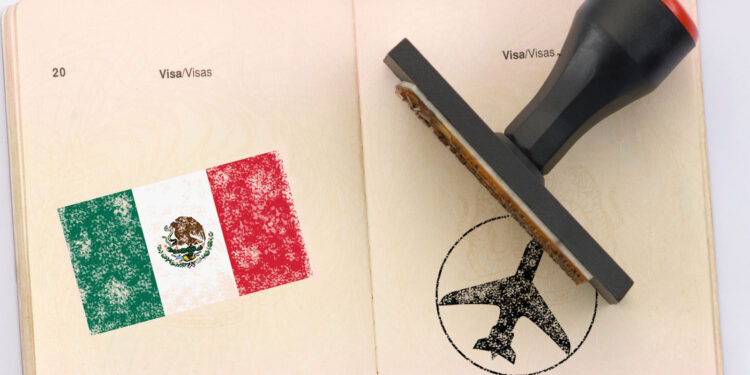Business Aviation Operations in Mexico – Navigating CIQ

This is a post by author Manuel Girault. Manuel is the general director at Universal Aviation Mexico, which has a Fixed-Base Operator (FBO) facility in Toluca and aircraft ground handling facilities in Cancun, Los Cabos and Cozumel. Manuel is an expert on business aircraft operations in Mexico and can be contacted at manuelgirault@universalaviation.aero.
This business aviation blog post is part of a series on operating in Mexico and continues from our last article: “Business Aviation Operations in Mexico – Ground Handling.”
For business aircraft operators, Customs, Immigration and Quarantine (CIQ) procedures go more smoothly and quickly when documentation is forwarded in advance to your ground handler. Beware of visa requirements and always ensure that you have correct Mexican insurance in place when operating to Mexico.
The following is an overview of what you need to know:
1. Know the crew clearance process in Mexico
Crew members usually clear customs after the passengers and are escorted to the General Aviation Terminal (GAT) or commercial terminal by the ground handler. Crew members clear CIQ and will, on occasion, be interviewed by the police or the military. Such interviews are seen at Cozumel (MMCZ) and Tapachula (MMTP), as these airports are subject to military inspection for all flights arriving from Latin America, South America or the Caribbean. CIQ clearance via a GAT or commercial terminal usually takes 30-45 minutes. At some airports, including Toluca (MMTO), the process is a little shorter – about 25 minutes. All aircraft documents will need to be presented by the crew at the Comandante office. In some cases at outlying airports, the crew will also need to make a permit payment after presenting the aircraft documents. Certain crew nationalities require visas, and it’s best to check with your ground handler in advance, as regulations may change. If a visa is required, it must be obtained prior to arrival, as crew members arriving without visas will not be allowed into the country. For certain nationalities, a visa is not needed for stays of up to 48 hours. If your stay is extended beyond 48 hours – for mechanical issues or emergencies – authorities may grant permission for a longer stay. The ground handler can assist with those arrangements. Please also note that the crew clearance can vary by airport, especially at outlying locations.
2. Passengers clear CIQ at GAT or commercial terminal
Depending on the airport, the ground handler will escort passengers to either the GAT or commercial terminal, where clearance is approximately 30-45 minutes. If visas are required, passengers must have them prior to arrival, or the passengers will not be allowed into the country. At some airports – including MMCZ – passengers use a separate line to clear CIQ in the commercial terminal. At other locations, such as Monterey (MMMY), the clearance is done at the commercial terminal, along with passengers that have arrived via commercial airlines. At this airport, there is no separate line for business aviation passengers. After clearance, passengers are escorted to their transportation outside the terminal. At MMTO, only crew/passengers usually board the aircraft after CIQ clearance to reposition to an FBO.
3. Clearance delays during the high season
The high season for Mexico is November through March. During this period of time, there may be some delays encountered during the customs and immigration clearance. Some locations where such delays may be encountered are Los Cabos (MMSD), MMCZ and Cancun (MMUN). In MMSD, delays of up to 40 minutes may be encountered, due to longer lines at the Comandante office. At MMCZ, there may be fewer customs and immigrations officers, which may create delays.
4. Fees are associated with the CIQ process
There are several government and immigration fees charged for CIQ clearance in Mexico. For a full list of the fees, please contact your 3rd-party provider or ground handler.
5. Know documentation requirements
Passengers must present passports and, when applicable, visas, along with customs and immigration cards. To reduce clearance time, your ground handler will pre-fill the customs and immigration cards. Crew members must present passports and, when required, visas, along with aircraft documentation. Documentation requirements include certificates of registration and airworthiness, worldwide insurance, Mexican insurance, pilot licenses and medical certificates. This process will be expedited if documents are forwarded to your ground handler in advance.
6. Consider agricultural restrictions
There are restrictions in place in terms of removing catering and agricultural items from business aviation aircraft in Mexico. At some airports, you may be able to store food items within the airport if refrigeration is available, and agriculture rules allow this. Alternatively, onboard food items will be trashed.
7. Be aware or restrictions regarding onboard pets
When traveling with a pet, you’ll need to provide a vaccination certificate from a licensed vet indicating the health of the animal and confirm that all vaccinations are up to date.
Conclusion
For any special needs or requirements – including requests for onboard CIQ clearance or importation of pets – it’s best to work with your ground handler well prior to day of operation.
Questions?
If you have any questions about this article or if you would like assistance with planning your next trip to Mexico, contact me at manuelgirault@universalaviation.aero.
Later, we’ll discuss PPRs and airport slots for Mexico and their impact on your trip.




